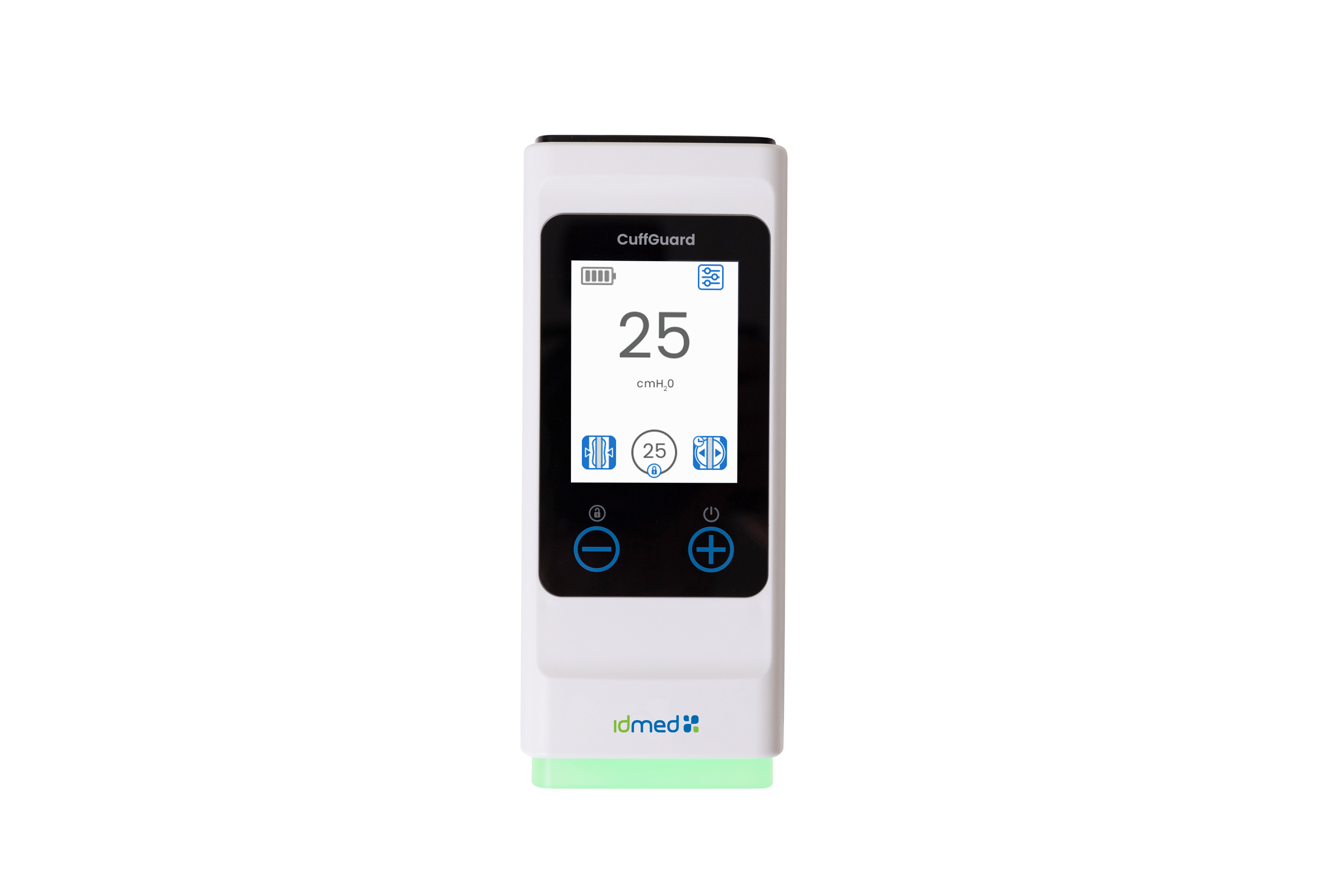
CUFF PRESSURE OPTIMAL MANAGEMENT
The CuffGuard automatically regulates the pressure of the endotracheal tube (ETT) cuff used during mechanical ventilation of patients. The device is designed to help in the prevention of complications associated with prolonged use of the ETT in intensive care, such as tracheal injury, aspiration of gastric fluids, ineffective ventilation and Ventilator-Associated Pneumonia (VAP).
Helps prevent the risk of VAP
By maintaining optimal cuff pressure, the CuffGuard ensures the sealing around the ETT cuff and considerably reduces the risk of infection, particularly VAP.
Effectively protects the trachea from injuries
The CuffGuard is a device for preventing tracheal lesions, offering effective protection against complications such as oedema or necrosis.
Allows effective patient ventilation
The CuffGuard plays an active role in protecting the patient’s airway, allowing caregivers to focus on other aspects of care while ensuring optimum ventilation.
Reduces caregivers’ exposure to infectious aerosols
Through precise and efficient cuff pressure management, the CuffGuard limits the spread of contaminated aerosols, thereby reducing caregivers’ risk of exposure to these infectious aerosols.
Facilitates the monitoring procedure
Automates cuff inflation
The Cuffguard ensures precise inflation to the nearest cmH20 eliminating room for human error and ensuring enhanced patient safety.
Eliminates the need for manual readjustment of cuff pressure
Without intervention, the ETT cuff looses pressure over time. Cuff pressure should be checked and adjusted every 8 to 12 hours. The automatic regulation supported by the CuffGuard ensures cuff pressure is consistently maintained at an optimum level, while eliminating the need for manual adjustment*.
Alerts for early leak detection
The CuffGuard warns the user in the event of malfunction, excessive pressure or leakage.
Optimisation of Endotracheal tube cuff pressure
The CuffGuard is used throughout the mechanical ventilation, until the Endotracheal tube is removed. The CuffGuard ensures that the cuff pressure is maintained at optimal level and avoids respiratory complications associated with inappropriate cuff pressure.
Adapted installation on tested ventilators
The CuffGuard can be connected to ventilators’ USB port. The synergy between the CuffGuard and the ventilator makes it much easier to use and improves its readability, enabling it to be integrated seamlessly into monitoring procedures.
Single patient tubing with anti-bacterial filter and one-way valve
The Cuffguard tubing features an antibacterial filter designed for single patient use to prevent cross contamination along with a one-way valve on the cuffguard connection that prevents cuff deflation if accidentally disconnected.
360° warning
The CuffGuard is equipped with audible and visual alarms to prevent any leaks or malfunctions. A 360-degree indicator light allows remote alerting without the need to be in front of the screen, giving extra peace of mind.
Readability in all circumstances
The CuffGuard’s high-definition, backlit display offers high contrast for excellent readability, even in low-light conditions. In addition, the display features an auto-rotation function that allows cuff pressure to be read from a distance, both vertically and horizontally.
Technical Data
Clinical
Automatic pressure control
Audible and visual alarm for leaks or malfunctions
Automatic deflation function
Momentary overinflation function
Ergonomics
Rotating touch screen
Battery life: 20 hours
Mains or USB type A power supply
Reduced dimensions 172 x 70.2 x 40.6 mm
Safety
Standard IEC 60601-1 Class IIa equipment.
Standard IEC 60601-1-8
CEM: IEC 60601-1-2
Performance
Adjustment range : 5 to 40 cm H2O
Cuff pressure measurement: Max 60 cm H2O
Setting resolution: +/- 1 cm H2O
Measurement resolution: +/- 1 cm H2O
Measurement accuracy: +/-2 cm H2O
Low sound level: < 30 dB
Testimonial
“We tested the CuffGuard for six weeks during the spring of 2024 in our ICU. This innovative medical device has provided numerous new insights. What I particularly appreciate is the continuous and accurate monitoring of the endotracheal tube cuff pressure, offering an easy read that allows caregivers to save time that they can dedicate to patients. Furthermore, the CuffGuard is an invaluable aid in medical and paramedical decision-making in cases of suspected porous cuff, facilitating the assessment of urgency and the changing of the ET tube if necessary. It integrates perfectly into an overall monitoring approach, complementing the information provided by the ventilator. Thanks to the CuffGuard, we have access to a multitude of unsuspected information, and I believe it has not yet finished revealing all its secrets…”
– Marc Weidlich
Anaesthetist nurse - Centre de Traitement de la Brûlure (Burn Treatment Centre), Bordeaux University Hospital







